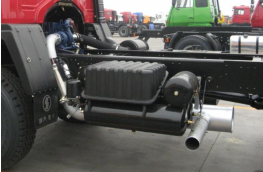In the complex structure of Shacman Heavy Trucks, the exhaust system is a crucial component. Its existence is not only for exhausting the waste gas produced by diesel engine combustion outside the vehicle but also has a profound impact on the overall performance, safety and compliance of the vehicle.
The design principle of the exhaust system is to use the smallest possible flow resistance to discharge the waste gas to a specific position outside the vehicle. This seemingly simple goal actually implies precise engineering design. To achieve smooth exhaust while minimizing flow resistance, careful consideration needs to be given to the shape, diameter and material of the pipeline. For example, adopting pipelines made of stainless steel with smooth inner walls can effectively reduce the frictional resistance during waste gas flow, thereby improving the exhaust efficiency.
However, the role of the exhaust system goes far beyond this. It has certain influences on the engine’s power, fuel consumption, emissions, heat load and noise. An optimized exhaust system can increase the engine’s power output and reduce fuel consumption. Conversely, if there are problems in the exhaust system, such as blockage or excessive resistance, it will lead to a decrease in engine power and an increase in fuel consumption. At the same time, the exhaust system also plays a key role in emission control. Through reasonable design and exhaust gas treatment devices, the emissions of harmful gases can be reduced to meet increasingly strict environmental protection standards.
From the perspective of heat load, the flow of high-temperature waste gas in the exhaust system generates a lot of heat. For safety considerations, corresponding measures must be taken to prevent the heat radiation of the exhaust system from damaging adjacent components. This may include using heat insulation materials in key parts or optimizing the pipeline layout to avoid direct contact between high-temperature areas and other sensitive components. For instance, setting up heat shields near the exhaust pipeline and the fuel tank, electrical circuits, etc., can effectively reduce the risks brought by heat radiation.
In terms of noise control, the position and direction of the exhaust tailpipe opening and the allowable exhaust noise value all need to refer to relevant national regulations and laws. The design of the exhaust system of Shacman Heavy Trucks must ensure that the exhaust noise is within the prescribed range to reduce noise pollution to the environment and drivers and passengers. To achieve this goal, methods such as using mufflers and optimizing the pipeline structure may be adopted to reduce noise.
In addition, the layout of the exhaust system must also consider its relationship with the engine intake port and the cooling、ventilation system. The exhaust needs to be kept away from the engine intake port to prevent the waste gas from being re-intaken, affecting the combustion efficiency and engine performance. At the same time, keeping away from the cooling and ventilation system can reduce the engine working temperature and ensure its stable operation within an appropriate temperature range.
In conclusion, the exhaust system of Shacman Heavy Trucks is a complex system integrating functionality, safety and compliance. Its design and optimization need to comprehensively consider multiple factors to achieve efficient exhaust, low energy consumption, low emissions, low noise and safe and reliable operation of the vehicle. Only when an ideal balance is achieved in all aspects can Shacman Heavy Trucks gallop on the road with more excellent performance.
Post time: Aug-19-2024









